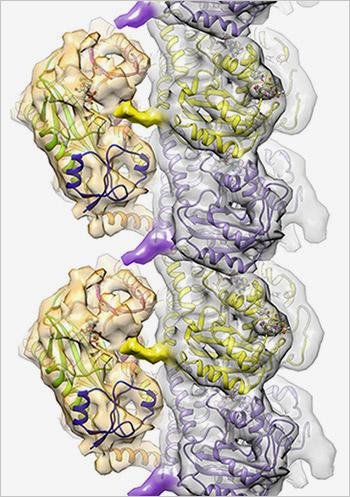Cellular code writer - TTLL7 (gold structures on the left) impacts cell function by binding to microtubules (silver structure made up of purple and yellow subunits) and adding chemical markers to the surface. Image courtesy of the Roll-Mecak lab.
LA JOLLA, Calif., May 12 (UPI) -- Scientists have discovered one of the main proteins that direct how a cell functions, giving them insight into how cells operate when damaged and, potentially, leading to therapies which can ease disorders linked to mutated cells in the body.
Much like road signs give drivers information about how and where to go, microtubules tagged by a specific family of chemicals influence the way that cells act. Researchers at the National Institutes of Health's National Institute of Neurological Disorders and Stroke have now seen tubulin tyrosine ligase-7, one of the most common of these molecules used by cells in the brain, attach to the microtubules and will be able to study how the "tubulin code" affects cells.
"This was a very surprising result, as no one had been able to visualize these tails on the microtubule before," Dr. Antonina Roll-Mecak said in a press release. "The microtubule markers are constantly being added and removed, depending on the local needs of the cell. Think about a highway system where street signs are constantly changing and roads are quickly built or torn apart."
During the study, Roll-Mecak and colleagues at the Scripps Research Institute used advanced imaging techniques to watch TTL7 mark tubules using glutamate tags. These tubules can affect everything in a cell from shape to what other molecules it allows inside itself. By discovering not only the proteins but seeing how they affect cells, scientists may now have an opportunity to watch the differences between healthy and damaged cells and how each are affected by the tubules.
Roll-Mecak said the lab will now start working to decipher the tubulin code in the hope that they can find new ways to help patients with neurodegenerative disorders, because they'll be starting with a protein already known to be key in how microtubules react to blunt trauma or cancer.
"We want to mix and match the TTLL proteins to see how we can control patterns of microtubule tagging. From that, we can learn how the cell is making those patterns and what happens during cellular damage, as in cancers or neurodegeneration, when these patterns are disrupted," said Dr. Roll-Mecak.
The discovery was first reported in the May 5 issue of Cell.















